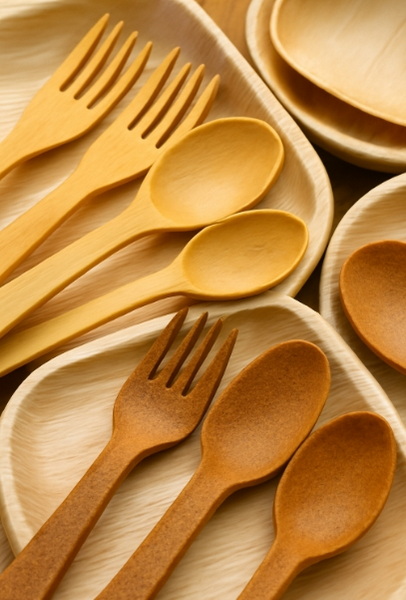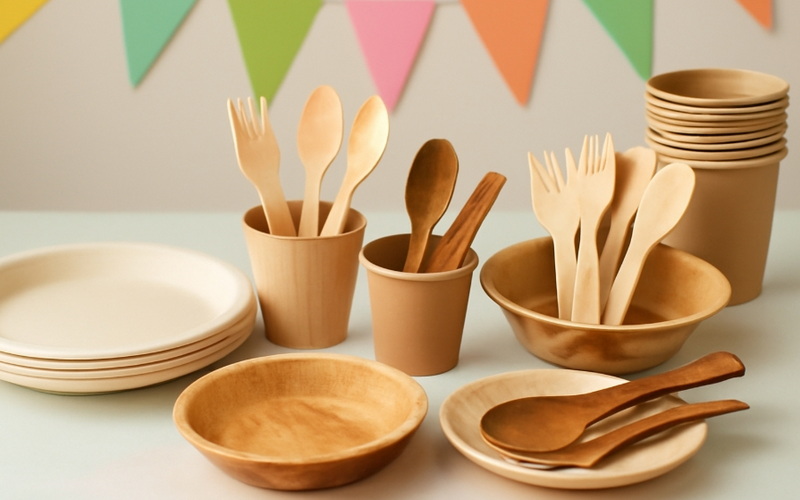
Content Menu
● The Environmental Impact of Plastic Disposable Partyware
>> Key Issues with Plastic Partyware
● Why Seek Alternatives?
● Popular Eco-Friendly Alternatives to Plastic Disposable Partyware
>> Compostable Bamboo Partyware
>> Sugarcane Bagasse Tableware
>> Palm Leaf Plates and Bowls
>> Wooden and Bamboo Cutlery
>> PLA and CPLA Bioplastic Cutlery
>> Edible Cutlery
● Comparing Eco-Friendly Partyware Options
● Practical Tips for Choosing Eco-Friendly Partyware
● Challenges and Considerations
● The Future of Eco-Friendly Partyware
● How to Host a Sustainable Party: Step-by-Step Guide
>> 1. Choose the Right Venue
>> 2. Send Digital Invitations
>> 3. Plan Your Menu Thoughtfully
>> 4. Select Eco-Friendly Partyware
>> 5. Set Up Clearly Marked Disposal Stations
>> 6. Decorate Sustainably
>> 7. Encourage Reuse
>> 8. Educate Your Guests
● Real-Life Success Stories
● The Role of Innovation in Sustainable Partyware
● How to Encourage Guests to Embrace Eco-Friendly Partyware
● Conclusion
● FAQ
>> 1. What is the best alternative to plastic disposable forks and spoons for parties?
>> 2. Can compostable partyware go in my home compost bin?
>> 3. Are eco-friendly partyware options more expensive than plastic?
>> 4. Do bamboo or wooden forks and spoons affect the taste of food?
>> 5. How can I ensure my partyware is truly eco-friendly?
As environmental awareness grows, more people are questioning the sustainability of everyday items, including fork and spoon plastic disposable partyware. Traditional plastic plates, cups, forks, and spoons have long been the go-to for parties and events, but their environmental cost is significant. This article explores whether eco-friendly alternatives exist, how they compare to conventional options, and what you should consider when planning your next gathering.

The Environmental Impact of Plastic Disposable Partyware
Plastic disposable partyware, including forks and spoons, is convenient but problematic. These items are typically used for a few hours and then discarded, often ending up in landfills or as litter in natural environments. Plastic does not biodegrade; instead, it breaks down into microplastics, contaminating soil and water and posing risks to wildlife and human health.
Key Issues with Plastic Partyware
- Longevity: Plastic items can persist in the environment for hundreds of years.
- Resource Use: Production relies on fossil fuels and energy-intensive processes.
- Waste Management: Most municipalities do not recycle small plastic utensils due to their size and contamination from food residues.
Why Seek Alternatives?
The push to find alternatives to fork and spoon plastic disposable partyware is driven by several factors:
- Environmental Protection: Reducing plastic waste helps protect ecosystems and wildlife.
- Health Concerns: Plastics can leach harmful chemicals into food and drinks.
- Regulations: Many regions are banning or restricting single-use plastics.
Popular Eco-Friendly Alternatives to Plastic Disposable Partyware
There are several sustainable options available today, each with its own advantages and challenges. Below, we explore the most popular alternatives for plates, cutlery, and cups.
Compostable Bamboo Partyware
Bamboo is a fast-growing, renewable resource that requires minimal water and no pesticides. Bamboo plates, forks, and spoons are sturdy, attractive, and fully compostable. They break down in a matter of months in industrial composting facilities and do not leave harmful residues behind. Bamboo partyware is also free from dyes and chemicals, making it a safe and eco-friendly choice for any event.
Sugarcane Bagasse Tableware
Bagasse is a by-product of sugarcane processing. Instead of being discarded or burned, it is pulped and molded into plates, bowls, and cutlery. Bagasse items are compostable, breaking down within months, and are suitable for both hot and cold foods. They are a robust alternative to both paper and plastic, offering leak resistance and durability.
Palm Leaf Plates and Bowls
Palm leaf partyware is made by collecting fallen palm leaves, which are then washed, pressed, and shaped into plates and bowls. This process uses no chemicals or artificial binders, resulting in a 100% natural product. Palm leaf plates are strong, leakproof, and microwave-safe, making them ideal for both casual and formal events. They decompose quickly and enrich the soil when composted.
Wooden and Bamboo Cutlery
Wooden and bamboo forks and spoons are widely available as alternatives to plastic. They are biodegradable, compostable, and often sourced from renewable forests. While some users note that wooden cutlery can have a different mouthfeel or taste compared to plastic, bamboo options tend to be smoother and more pleasant to use.
PLA and CPLA Bioplastic Cutlery
PLA (polylactic acid) and CPLA (crystallized PLA) are plant-based plastics derived from corn or sugarcane. These materials look and feel similar to traditional plastic but are compostable in industrial facilities. PLA cutlery is sturdy and heat-resistant, making it a practical choice for parties. However, it requires specific composting conditions to break down fully.
Edible Cutlery
Innovative companies have developed edible forks and spoons made from grains like sorghum, rice, and wheat. These utensils can be eaten after use or composted, breaking down within days. Edible cutlery is a fun, conversation-starting alternative, especially at eco-themed events.
Comparing Eco-Friendly Partyware Options
| Material | Compostable | Biodegradable | Microwave Safe | Sturdy for Wet/Hot Foods | Chemical-Free | Notable Downsides |
| Bamboo | Yes | Yes | Yes | Yes | Yes | Can be pricier |
| Bagasse (Sugarcane) | Yes | Yes | Yes | Yes | Usually | Some brands use coatings |
| Palm Leaf | Yes | Yes | Yes | Yes | Yes | Limited availability |
| Wooden Cutlery | Yes | Yes | No | Moderate | Sometimes | Taste/texture issues |
| PLA/CPLA Bioplastic | Yes* | Yes* | Yes | Yes | Yes | Needs industrial compost |
| Edible Cutlery | Yes | Yes | Yes | Moderate | Yes | Shelf life, cost |
Practical Tips for Choosing Eco-Friendly Partyware
- Check Compostability: Look for certifications indicating that items are compostable and free from harmful chemicals.
- Consider Your Waste Management Options: If you lack access to industrial composting, prefer products that are home-compostable.
- Buy in Bulk: Purchasing partyware in larger quantities can reduce cost and packaging waste.
- Educate Guests: Provide clear instructions on how to dispose of used partyware to ensure proper composting or recycling.
Challenges and Considerations
While eco-friendly alternatives to fork and spoon plastic disposable partyware are increasingly available, there are some challenges to consider:
- Cost: Sustainable options can be more expensive than conventional plastic.
- Performance: Some materials, like wooden cutlery, may not perform as well with certain foods.
- Composting Infrastructure: Not all regions have access to commercial composting facilities, which are required for some bioplastics.
- Product Quality: Always check for certifications and reviews to ensure the products meet your needs.
The Future of Eco-Friendly Partyware
The market for sustainable partyware is rapidly evolving. Innovations such as edible cutlery, reusable designs, and new compostable materials are making it easier than ever to host eco-conscious events. As consumer demand grows and regulations tighten, expect even more options to become available.

How to Host a Sustainable Party: Step-by-Step Guide
Planning a sustainable party goes beyond simply swapping out fork and spoon plastic disposable partyware for eco-friendly versions. Here's a step-by-step guide to make your next event as green as possible:
1. Choose the Right Venue
Select a location that encourages sustainable practices. Outdoor spaces, community centers, or venues with recycling and composting facilities are ideal.
2. Send Digital Invitations
Avoid paper waste by using digital invites. There are many platforms that make it easy to send beautiful, customizable invitations via email or messaging apps.
3. Plan Your Menu Thoughtfully
Opt for locally sourced, seasonal foods. This reduces the carbon footprint associated with food transportation and supports local farmers.
4. Select Eco-Friendly Partyware
Choose from the eco-friendly alternatives discussed above. Ensure your fork and spoon plastic disposable partyware is made from bamboo, bagasse, palm leaf, or other compostable materials.
5. Set Up Clearly Marked Disposal Stations
Provide bins for compost, recycling, and landfill waste. Use signs to educate guests on where to dispose of their used partyware.
6. Decorate Sustainably
Use reusable decorations, potted plants, or items made from recycled materials. Avoid balloons, confetti, and other single-use plastics.
7. Encourage Reuse
If possible, use washable tablecloths, napkins, and serving dishes. For smaller gatherings, consider borrowing or renting reusable items.
8. Educate Your Guests
Let your guests know about your sustainability efforts. Share why you chose eco-friendly fork and spoon plastic disposable partyware and how they can help by disposing of it correctly.
Real-Life Success Stories
Many individuals and organizations have successfully transitioned to eco-friendly partyware. Community groups have hosted zero-waste picnics using only compostable plates, forks, and spoons. Weddings and corporate events are increasingly opting for bamboo or palm leaf partyware, receiving positive feedback from guests who appreciate the environmental consideration.
Some schools have even implemented programs where students use edible cutlery during lunch, turning sustainability into an educational opportunity. These stories demonstrate that with a little planning, it's entirely possible to host memorable events without relying on traditional plastic disposables.
The Role of Innovation in Sustainable Partyware
The world of eco-friendly partyware is constantly evolving. Startups and established companies alike are investing in new materials and designs. For example, researchers are developing utensils from seaweed, mushroom mycelium, and even upcycled agricultural waste. These innovations promise to make sustainable partyware even more accessible and affordable in the future.
Additionally, some companies are introducing reusable partyware rental services. These services deliver, collect, and wash plates, cups, and cutlery, eliminating the need for single-use items altogether. This model is especially popular for large events and is gaining traction in cities worldwide.
How to Encourage Guests to Embrace Eco-Friendly Partyware
Switching to sustainable fork and spoon plastic disposable partyware is a great first step, but guest participation is crucial for success. Here are some strategies to encourage your guests:
- Lead by Example: Use only eco-friendly partyware at your event.
- Communicate Clearly: Let guests know why you've chosen sustainable options and how they can help.
- Make It Fun: Turn proper disposal into a game or competition.
- Provide Incentives: Offer small rewards for guests who participate in composting or recycling efforts.
Conclusion
There are indeed many eco-friendly alternatives to fork and spoon plastic disposable partyware. From bamboo and bagasse to palm leaf and edible options, these products offer a sustainable way to celebrate without harming the planet. While some challenges remain—such as cost and composting infrastructure—the shift toward greener partyware is both necessary and achievable. By making informed choices and encouraging others to do the same, you can help reduce plastic waste and support a healthier environment for future generations.

FAQ
1. What is the best alternative to plastic disposable forks and spoons for parties?
The best alternatives are compostable bamboo or bagasse cutlery, which are sturdy, chemical-free, and break down quickly in compost. Palm leaf utensils and edible cutlery are also excellent options for eco-conscious events.
2. Can compostable partyware go in my home compost bin?
Some items, like uncoated bamboo, bagasse, and palm leaf plates, can be composted at home, though they may take longer to break down. PLA and CPLA bioplastics usually require industrial composting facilities.
3. Are eco-friendly partyware options more expensive than plastic?
Yes, sustainable alternatives often cost more due to the materials and processes involved. However, bulk purchasing and growing demand are helping to reduce prices over time.
4. Do bamboo or wooden forks and spoons affect the taste of food?
Some users report a slight woody taste with wooden cutlery, but bamboo utensils are generally smoother and less likely to affect flavor. Edible cutlery can add a unique taste, depending on the ingredients used.
5. How can I ensure my partyware is truly eco-friendly?
Look for certifications such as FSC, USDA Biobased, or BPI Compostable. Avoid products with chemical coatings or dyes, and verify whether the items are suitable for home or industrial composting.

















